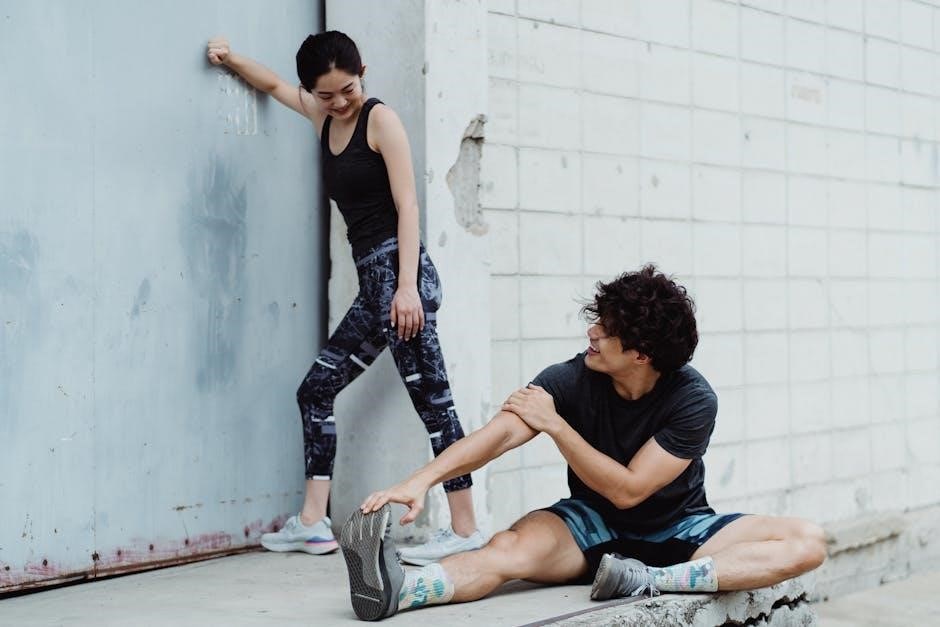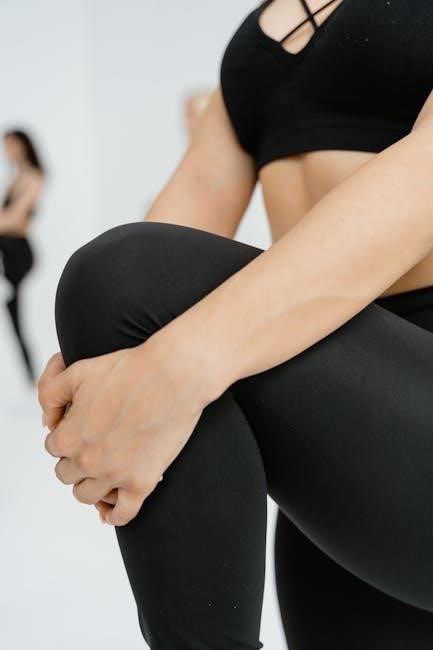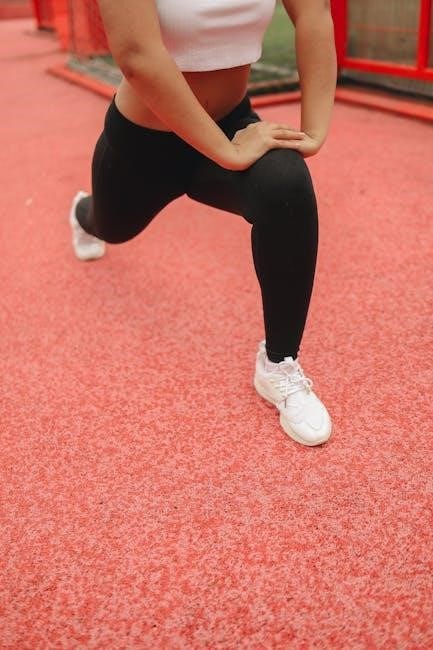Stretching is a fundamental element of a runner’s routine‚ essential for improving flexibility‚ preventing injuries‚ and enhancing performance. Dynamic and static stretches target key muscle groups‚ ensuring optimal mobility and recovery. A consistent stretching routine supports long-term running health and overall well-being.

Dynamic Stretching for Runners
Dynamic stretching involves active movements that improve flexibility and prepare muscles for running. Exercises like leg swings‚ high knees‚ and butt kicks enhance circulation and reduce stiffness‚ making it ideal before a run to boost performance and prevent injuries.
Pre-Run Dynamic Stretches
Pre-run dynamic stretches are essential for preparing the body for physical activity. They involve active‚ moving stretches that increase blood flow and warm up the muscles. Common exercises include leg swings‚ hip circles‚ and arm circles‚ which help improve flexibility and range of motion. Another effective stretch is the lunge walk‚ which targets the hips and hamstrings. Additionally‚ high knees and butt kicks engage the lower body‚ mimicking running movements. These dynamic stretches should be performed for about 10-15 minutes before running to reduce muscle stiffness and prevent injuries. Consistency is key‚ as regular dynamic stretching can enhance performance and support long-term running health. Incorporating these exercises into a pre-run routine ensures that runners are well-prepared for their workout.
Static Stretching for Runners
Static stretching involves holding stretches for 15-30 seconds to improve flexibility and reduce muscle tension. It targets major muscle groups like hamstrings‚ quadriceps‚ and hip flexors‚ promoting recovery and maintaining muscle balance after runs.

Post-Run Static Stretches
Post-run static stretching is essential for promoting recovery‚ reducing muscle soreness‚ and improving flexibility. After cooling down‚ focus on stretches targeting key muscle groups used during running‚ such as hamstrings‚ quadriceps‚ hip flexors‚ and calves. Hold each stretch for 15-30 seconds to allow muscles to relax and lengthen. Hamstring stretches can be performed by sitting on the floor with legs extended‚ reaching toward the toes. For quadriceps‚ stand and pull one heel toward the buttocks‚ holding for 30 seconds per side. Hip flexor stretches involve kneeling with one knee bent and the other leg extended‚ leaning forward slightly. Calf stretches can be done by standing facing a wall‚ stepping one foot back‚ and pressing the heel toward the ground. Regular post-run static stretching helps prevent tightness‚ enhances range of motion‚ and supports overall muscle balance‚ making it a crucial part of a runner’s routine.
Benefits of Stretching for Runners
Stretching offers numerous benefits for runners‚ enhancing performance and overall well-being. Regular stretching improves flexibility‚ allowing for a greater range of motion and more efficient running mechanics. It also reduces muscle tension‚ minimizing the risk of injury and alleviating post-run soreness. Additionally‚ stretching promotes better circulation‚ aiding in the delivery of oxygen and nutrients to muscles‚ which supports recovery. Many runners find that consistent stretching enhances their endurance and speed‚ enabling them to train more effectively. Furthermore‚ stretching can improve posture and balance‚ reducing the strain on joints during runs. Incorporating both dynamic and static stretches into a routine ensures that muscles remain supple and strong‚ contributing to long-term running health. By making stretching a priority‚ runners can optimize their training‚ recover faster‚ and perform at their best.
Preventing Injuries Through Stretching
Stretching is a crucial tool for preventing injuries in runners by addressing muscle imbalances and enhancing flexibility. Tight muscles‚ particularly in the hamstrings‚ hip flexors‚ and calves‚ are common causes of injuries such as pulled muscles or strains. Regular stretching helps maintain optimal muscle length‚ reducing the risk of overuse injuries like shin splints and runner’s knee. Dynamic stretches before a run prepare the muscles for activity‚ improving joint mobility and reducing stiffness. Static stretches after a run help cool down the muscles‚ preventing soreness and promoting recovery. Consistently incorporating both types of stretches into a routine can significantly lower the likelihood of injuries. Additionally‚ stretching improves posture and alignment‚ ensuring proper running mechanics and reducing repetitive strain on joints. By prioritizing stretching‚ runners can create a protective barrier against common injuries‚ allowing them to train consistently and maintain peak performance. A well-rounded stretching routine is essential for long-term injury prevention and overall running health.

Strength Training and Flexibility
Strength training and flexibility are complementary components of a runner’s routine‚ working together to enhance performance and prevent injuries. Building muscular strength improves running efficiency‚ power‚ and endurance‚ while flexibility ensures proper muscle function and range of motion. When combined‚ these elements create a balanced approach to training. Strength exercises target key areas like the core‚ glutes‚ and legs‚ which are essential for stability and propulsion during runs. Flexibility‚ achieved through stretching‚ allows for optimal joint mobility and reduces muscle tightness‚ which can hinder performance. Together‚ they promote better running mechanics and reduce the risk of overuse injuries. A well-structured program that includes both strength training and stretching helps runners maintain consistent progress and achieve their goals. By integrating these practices‚ runners can build resilience‚ improve overall fitness‚ and enhance their ability to perform at their best. This balanced approach is vital for long-term success and injury-free running.

Morning Stretching Routine for Runners
A morning stretching routine for runners targets major muscle groups‚ improving flexibility and reducing injury risk. Focus on neck‚ shoulder‚ hamstring‚ and calf stretches‚ holding each for 15-30 seconds. Consistency is key for optimal benefits and long-term flexibility.
Key Morning Stretches
Key morning stretches for runners focus on major muscle groups to enhance flexibility and prepare for daily activities. Start with gentle neck stretches‚ rolling your head in circular motions to loosen tension. Shoulder rolls and chest opens help improve posture and reduce stiffness. Hamstring stretches‚ such as seated or standing reaches‚ are essential for maintaining leg flexibility. Calf stretches‚ performed against a wall or on a step‚ target the lower legs‚ crucial for runners. Additionally‚ hip flexor stretches‚ like lunges‚ and quadriceps stretches‚ done while standing‚ further enhance mobility. Each stretch should be held for 15-30 seconds and repeated 2-3 times to maximize effectiveness. Incorporating these exercises into a consistent morning routine supports overall muscle balance and reduces injury risk‚ ensuring runners feel refreshed and ready for the day ahead.
